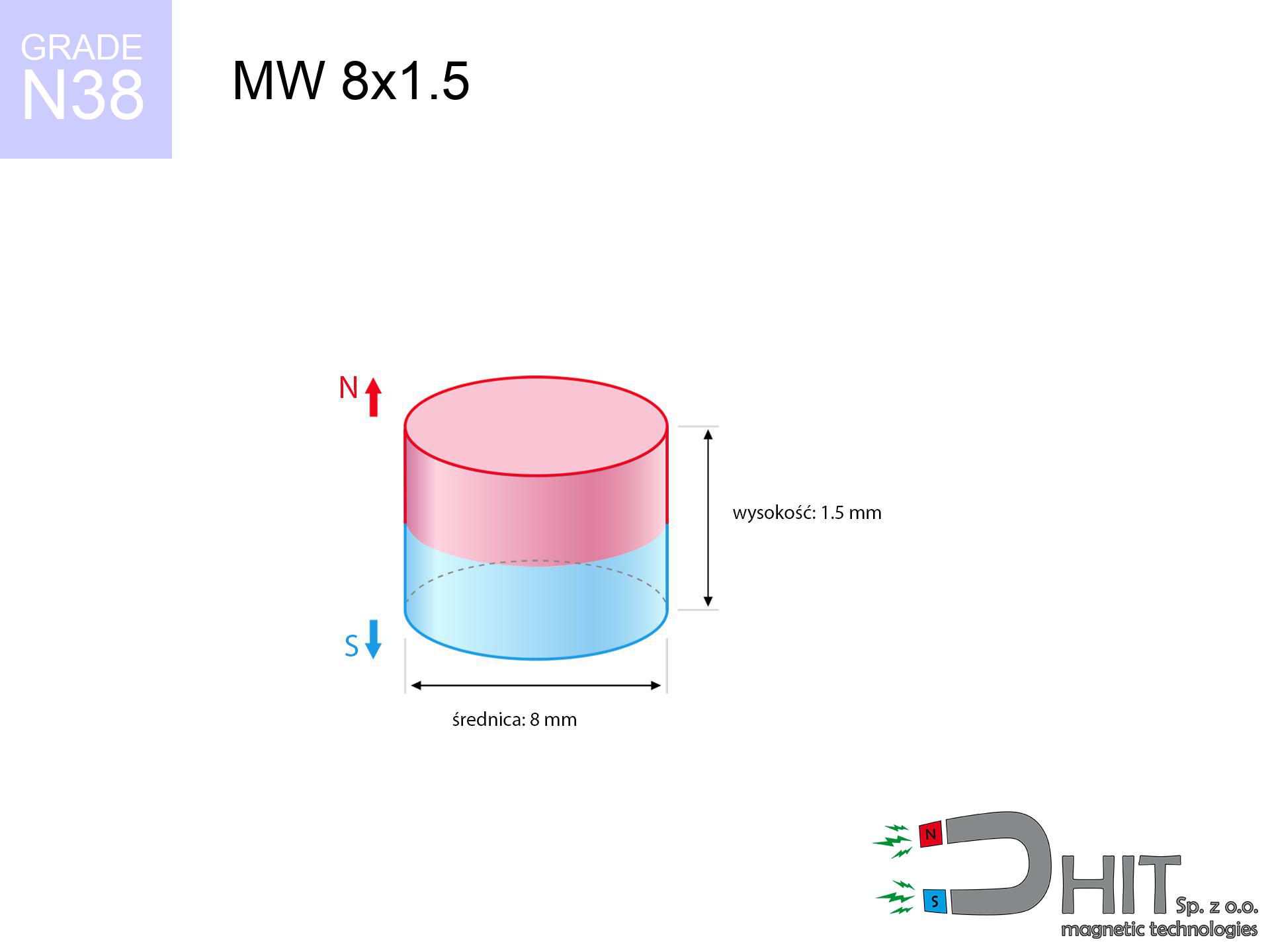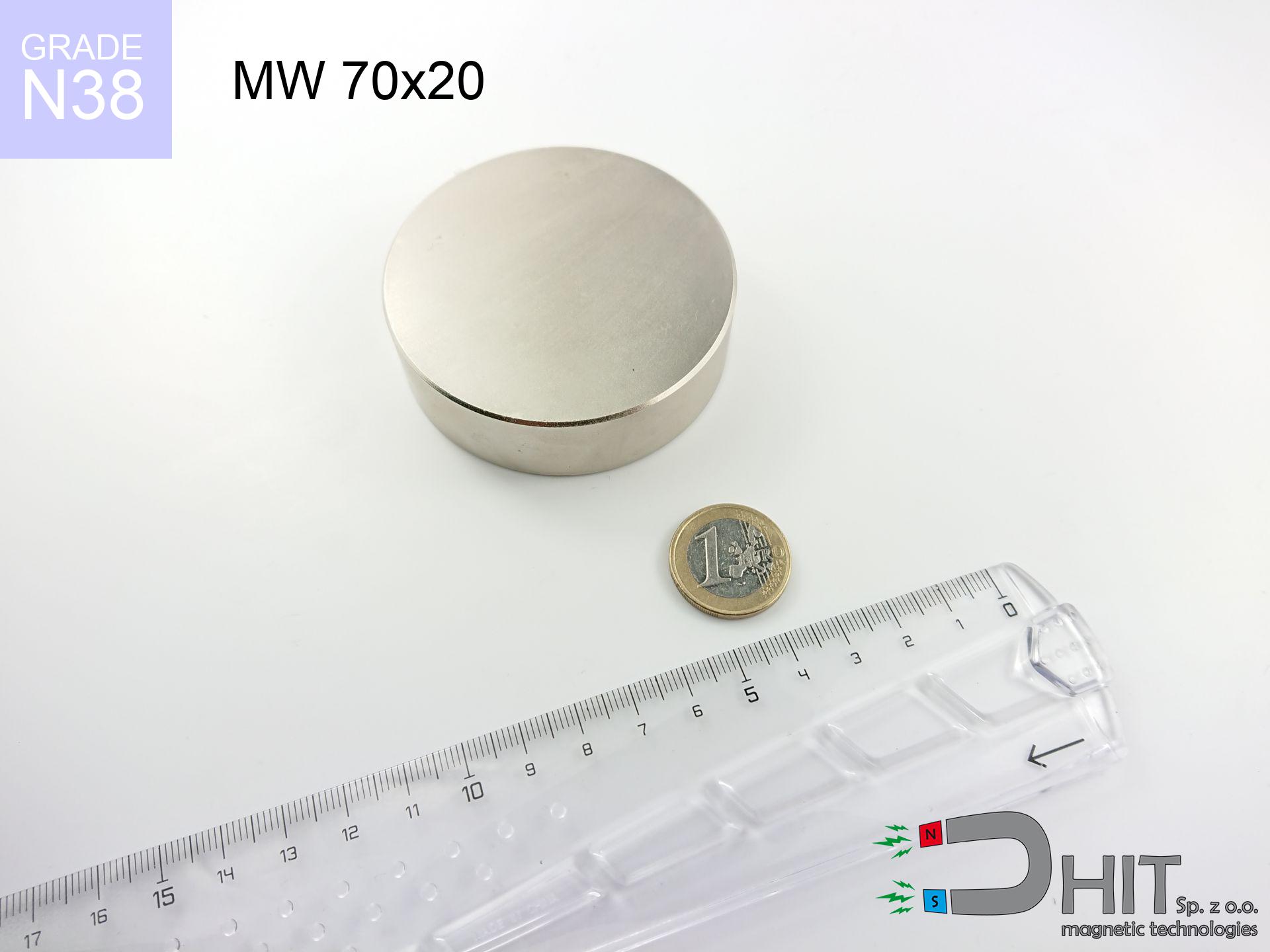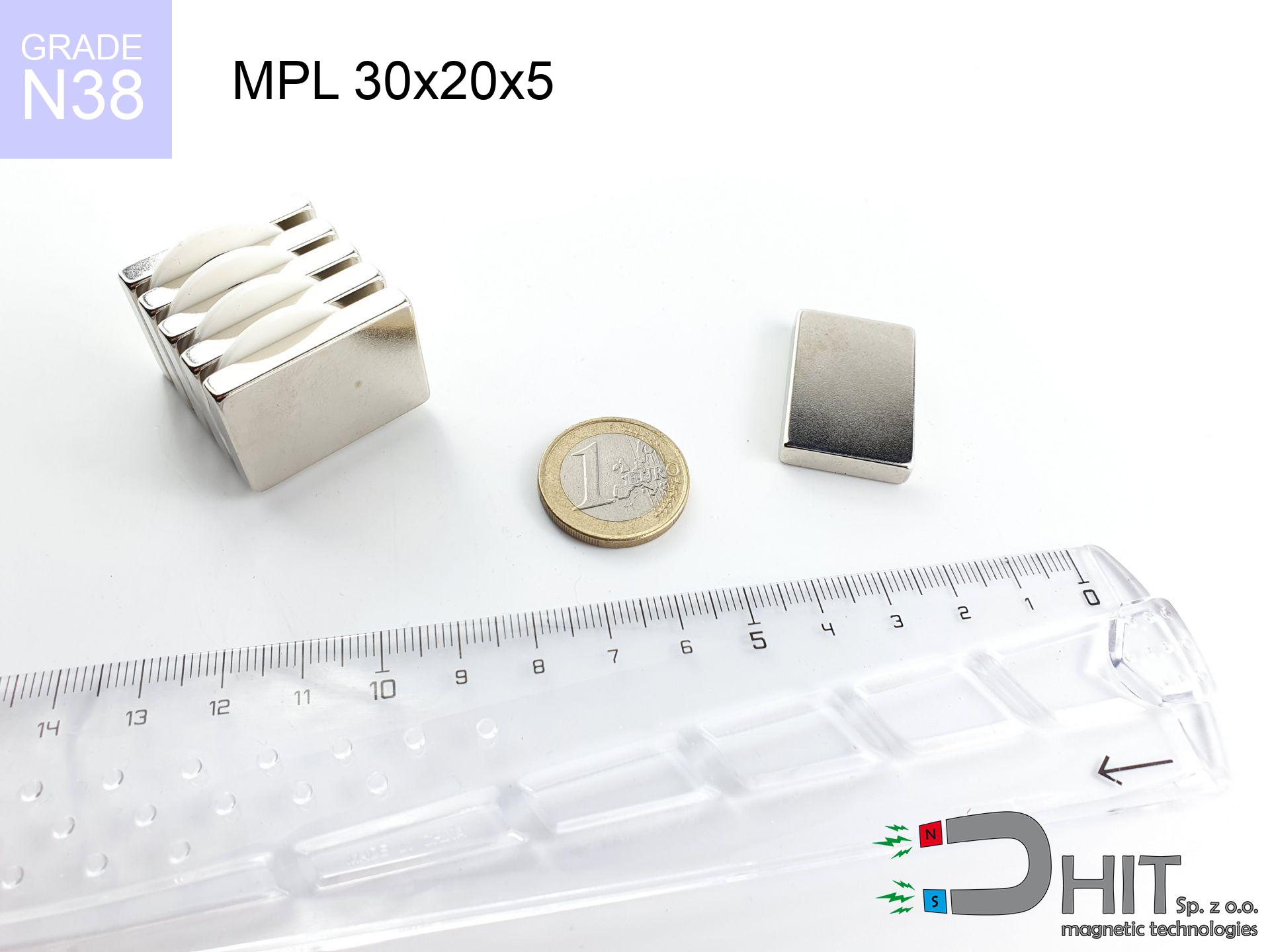MW 8x1.5 / N38 - neodymium magnet
cylindrical magnet
catalog number 010101
GTIN: 5906301811008
diameter Ø
8
mm [±0,1 mm]
height
1.5
mm [±0,1 mm]
magnetizing direction
↑ axial
capacity ~
0.66 kg / 6.47 N
magnetic induction ~
217.52 mT / 2,175 Gs
max. temperature
≤ 80
°C
catalog number 010101
GTIN: 5906301811008
diameter Ø
8 mm [±0,1 mm]
height
1.5 mm [±0,1 mm]
magnetizing direction
↑ axial
capacity ~
0.66 kg / 6.47 N
magnetic induction ~
217.52 mT / 2,175 Gs
max. temperature
≤ 80 °C
0.46 ZŁ gross price (including VAT) / pcs +
0.37 ZŁ net price + 23% VAT / pcs
bulk discounts:
need more quantity?Want to talk about magnets?
Give us a call tel: +48 22 499 98 98 or contact us through contact form on the contact page. You can check the lifting capacity and the shape of neodymium magnet in our force calculator power calculator
Orders placed by 2:00 PM will be shipped on the same business day.
Specification: cylindrical magnet 8x1.5 / N38 ↑ axial
Magnetic properties of the material N38
Physical properties of sintered neodymium magnets Nd2Fe14B
Moreover, although neodymium is part of the strongest magnets, they are susceptible to corrosion in humid environments. Therefore, they are coated with a thin layer of gold to increase their durability. Interestingly that NdFeB neodymium magnets are about 13% lighter than SmCo magnets and, despite their power, are brittle, which requires special caution during their handling. Therefore, any mechanical processing should be done before they are magnetized.
In terms of safety, there are many recommendations regarding the use of these magnets. They should not be used in acidic, basic, organic environments or in solvents, and also in water or oil. Furthermore, they can distort data on magnetic cards and hard drives, although data deletion using a neodymium magnet is not guaranteed.
In terms of properties in different environments, neodymium magnets are sensitive to corrosion, especially in conditions of high humidity. Therefore, they are often coated with thin coatings, such as gold, to protect them from external factors and extend their lifespan. Temperatures exceeding 130°C can cause a reduction of their magnetic properties, although there are particular types of neodymium magnets that can withstand temperatures up to 230°C.
As for risks, it is important to avoid using neodymium magnets in acidic conditions, basic conditions, organic or solvent environments, unless they are properly protected. Additionally, their use is not recommended in wet conditions, oil, or in an atmosphere containing hydrogen, as they may lose their magnetic strength.
Shopping tips
Advantages as well as disadvantages of neodymium magnets NdFeB.
Apart from immense power, neodymium magnets have the following advantages:
- They do not lose strength over time - after approximately 10 years, their strength decreases by only ~1% (theoretically),
- They protect against demagnetization caused by external magnetic sources extremely well,
- In other words, thanks to the glossy nickel, gold, or silver finish, the element gains an aesthetic appearance,
- They have very high magnetic induction on the surface of the magnet,
- By using an appropriate combination of materials, they can achieve high thermal resistance, allowing them to operate at temperatures up to 230°C and above...
- The ability for precise shaping and customization to specific needs – neodymium magnets can be produced in a wide range of shapes and sizes, which enhances their versatility in applications.
- Significant importance in modern technologies – find application in computer drives, electric drive mechanisms, medical equipment or very highly developed apparatuses.
Disadvantages of neodymium magnets:
- They are prone to breaking as they are fragile when subjected to a powerful impact. If the magnets are exposed to impacts, it is suggested using magnets in a metal holder. The steel housing in the form of a holder protects the magnet from impacts and also increases its overall strength,
- They lose strength at high temperatures. Most neodymium magnets experience permanent loss of strength when heated above 80°C (depending on the form and height). However, we also offer special magnets with high temperature resistance, up to 230°C,
- Magnets exposed to a humid environment can corrode. Therefore, when using them outdoors, we recommend using waterproof magnets made of rubber, plastic, or other moisture-resistant materials,
- The use of a cover - a magnetic holder is recommended due to the limited production capabilities of creating threads or complex shapes in the magnet
- Potential hazard associated with microscopic parts of magnets can be dangerous, if swallowed, which is particularly important in the context of child safety. Furthermore, miniscule components of these magnets have the potential to hinder the diagnostic process in case of swallowing.
Exercise Caution with Neodymium Magnets
Neodymium magnets should not be around children.
Neodymium magnets are not toys. Do not allow children to play with them. In the case of swallowing multiple magnets simultaneously, they can attract to each other through the intestinal walls. In the worst case scenario, this can lead to death.
Keep neodymium magnets away from the wallet, computer, and TV.
Magnetic fields generated by neodymium magnets can damage magnetic storage media such as floppy disks, credit cards, magnetic ID cards, cassette tapes, video tapes, or other similar devices. They can also damage televisions, VCRs, computer monitors, and CRT displays. Avoid placing neodymium magnets in close proximity to electronic devices.
Neodymium magnets are among the strongest magnets on Earth. The surprising force they generate between each other can surprise you.
On our website, you can find information on how to use neodymium magnets. This will help you avoid injuries and prevent damage to the magnets.
Neodymium magnets are primarily characterized by their significant internal force. They attract to each other, and any object that comes in their way will be affected.
Neodymium magnets bounce and also touch each other mutually within a distance of several to almost 10 cm from each other.
Keep neodymium magnets away from GPS and smartphones.
Neodymium magnets generate intense magnetic fields that interfere with magnetometers and compasses used in navigation, as well as internal compasses of smartphones and GPS devices.
The magnet is coated with nickel - be careful if you have an allergy.
Studies show a small percentage of people have allergies to certain metals, including nickel. An allergic reaction often manifests as skin redness and rash. If you have a nickel allergy, you can try wearing gloves or simply avoid direct contact with nickel-plated neodymium magnets.
Neodymium magnets can become demagnetized at high temperatures.
Although magnets have demonstrated their effectiveness up to 80°C or 175°F, the temperature can vary depending on the type, shape, and intended use of the specific magnet.
Neodymium magnets are fragile as well as can easily break as well as shatter.
Neodymium magnets are extremely delicate, and by joining them in an uncontrolled manner, they will crumble. Neodymium magnets are made of metal and coated with a shiny nickel surface, but they are not as hard as steel. At the moment of collision between the magnets, sharp metal fragments can be dispersed in different directions.
Dust and powder from neodymium magnets are flammable.
Avoid drilling or mechanical processing of neodymium magnets. Once crushed into fine powder or dust, this material becomes highly flammable.
Neodymium magnets are not recommended for people with pacemakers.
Neodymium magnets generate very strong magnetic fields that can interfere with the operation of a pacemaker. This is because many of these devices are equipped with a function that deactivates the device in a magnetic field.
To show why neodymium magnets are so dangerous, see the article - How very dangerous are strong neodymium magnets?.








